
在本指南中,我们将逐步介绍如何使用 Spring Boot 创建一个简单但全面的微服务系统。我们将介绍微服务的基础知识,设置所需的环境,并实现两个微服务:OrderService 和 InventoryService。此外,我们将使用 Eureka 和 API 网关集成服务发现来管理服务之间的路由。
微服务是一种软件架构风格,其中应用程序被构建为协同工作的小型独立服务的集合。每个服务都是独立的,并通过明确定义的 API 与其他服务进行通信,使系统更加灵活、可扩展且更易于管理。
我们系统的架构将由两个微服务组成:OrderService 和 InventoryService。 OrderService 将使用关系数据库 (MySQL) 来存储订单详细信息,而 InventoryService 将使用 NoSQL 数据库 (MongoDB) 来管理库存数据。我们还将使用 Eureka 实现服务发现,并使用 API 网关来路由请求。
在我们开始之前,请确保您已安装以下工具:
打开 src/main/resources 中的 application.properties 文件,添加以下配置:
spring.datasource.url=jdbc:mysql://localhost:3306/orderservice spring.datasource.username=root spring.datasource.password=yourpassword spring.datasource.driver-class-name=com.mysql.cj.jdbc.Driver spring.jpa.hibernate.ddl-auto=update spring.jpa.show-sql=true spring.jpa.properties.hibernate.dialect=org.hibernate.dialect.MySQL8Dialect server.port=8081
在 src/main/java/com/ordersystem/orderservice/model/Order.java 中创建 Order 实体类:
package com.ordersystem.orderservice.model;
import lombok.AllArgsConstructor;
import lombok.Data;
import lombok.NoArgsConstructor;
import javax.persistence.*;
@Data
@AllArgsConstructor
@NoArgsConstructor
@Entity
@Table(name = "orders")
public class Order {
@Id
@GeneratedValue(strategy = GenerationType.IDENTITY)
private Long id;
private String product;
private int quantity;
private double price;
}
在 src/main/java/com/ordersystem/orderservice/repository/OrderRepository.java 中创建 OrderRepository 接口:
package com.ordersystem.orderservice.repository;
import com.ordersystem.orderservice.model.Order;
import org.springframework.data.jpa.repository.JpaRepository;
public interface OrderRepository extends JpaRepository<Order, Long> {
}
在 src/main/java/com/ordersystem/orderservice/service/OrderService.java 中创建 OrderService 类:
package com.ordersystem.orderservice.service;
import com.ordersystem.orderservice.model.Order;
import com.ordersystem.orderservice.repository.OrderRepository;
import org.springframework.beans.factory.annotation.Autowired;
import org.springframework.stereotype.Service;
import java.util.List;
@Service
public class OrderService {
@Autowired
private OrderRepository orderRepository;
public List<Order> getAllOrders() {
return orderRepository.findAll();
}
public Order getOrderById(Long id) {
return orderRepository.findById(id).orElse(null);
}
public Order createOrder(Order order) {
return orderRepository.save(order);
}
public void deleteOrder(Long id) {
orderRepository.deleteById(id);
}
}
在 src/main/java/com/ordersystem/orderservice/controller/OrderController.java 中创建 OrderController 类:
package com.ordersystem.orderservice.controller;
import com.ordersystem.orderservice.model.Order;
import com.ordersystem.orderservice.service.OrderService;
import org.springframework.beans.factory.annotation.Autowired;
import org.springframework.web.bind.annotation.*;
import java.util.List;
@RestController
@RequestMapping("/api/orders")
public class OrderController {
@Autowired
private OrderService orderService;
@GetMapping
public List<Order> getAllOrders() {
return orderService.getAllOrders();
}
@GetMapping("/{id}")
public Order getOrderById(@PathVariable Long id) {
return orderService.getOrderById(id);
}
@PostMapping
public Order createOrder(@RequestBody Order order) {
return orderService.createOrder(order);
}
@DeleteMapping("/{id}")
public void deleteOrder(@PathVariable Long id) {
orderService.deleteOrder(id);
}
}
打开 src/main/resources 中的 application.properties 文件,添加以下配置:
spring.data.mongodb.uri=mongodb://localhost:27017/inventoryservice server.port=8082
在 src/main/java/com/ordersystem/inventoryservice/model/InventoryItem.java 中创建 InventoryItem 实体类:
package com.ordersystem.inventoryservice.model;
import lombok.AllArgsConstructor;
import lombok.Data;
import lombok.NoArgsConstructor;
import org.springframework.data.annotation.Id;
import org.springframework.data.mongodb.core.mapping.Document;
@Data
@AllArgsConstructor
@NoArgsConstructor
@Document(collection = "inventory")
public class InventoryItem {
@Id
private String id;
private String product;
private int quantity;
}
在 src/main/java/com/ordersystem/inventoryservice/repository/InventoryRepository.java 中创建 InventoryRepository 接口:
package com.ordersystem.inventoryservice.repository;
import com.ordersystem.inventoryservice.model.InventoryItem;
import org.springframework.data.mongodb.repository.MongoRepository;
public interface InventoryRepository extends MongoRepository<InventoryItem, String> {
}
Create the InventoryService class in src/main/java/com/ordersystem/inventoryservice/service/InventoryService.java:
package com.ordersystem.inventoryservice.service;
import com.ordersystem.inventoryservice.model.InventoryItem;
import com.ordersystem.inventoryservice.repository.InventoryRepository;
import org.springframework.beans.factory.annotation.Autowired;
import org.springframework.stereotype.Service;
import java.util.List;
@Service
public class InventoryService {
@Autowired
private InventoryRepository inventoryRepository;
public List<InventoryItem> getAllItems() {
return inventoryRepository.findAll();
}
public InventoryItem getItemById(String id) {
return inventoryRepository.findById(id).orElse(null);
}
public InventoryItem createItem(InventoryItem item) {
return inventoryRepository.save(item);
}
public void deleteItem(String id) {
inventoryRepository.deleteById(id);
}
}
Create the InventoryController class in src/main/java/com/ordersystem/inventoryservice/controller/InventoryController.java:
package com.ordersystem.inventoryservice.controller;
import com.ordersystem.inventoryservice.model.InventoryItem;
import com.ordersystem.inventoryservice.service.InventoryService;
import org.springframework.beans.factory.annotation.Autowired;
import org.springframework.web.bind.annotation.*;
import java.util.List;
@RestController
@RequestMapping("/api/inventory")
public class InventoryController {
@Autowired
private InventoryService inventoryService;
@GetMapping
public List<InventoryItem> getAllItems() {
return inventoryService.getAllItems();
}
@GetMapping("/{id}")
public InventoryItem getItemById(@PathVariable String id) {
return inventoryService.getItemById(id);
}
@PostMapping
public InventoryItem createItem(@RequestBody InventoryItem item) {
return inventoryService.createItem(item);
}
@DeleteMapping("/{id}")
public void deleteItem(@PathVariable String id) {
inventoryService.delete
Item(id);
}
}
Open the application.properties file in src/main/resources and add the following configuration:
server.port=8761 eureka.client.register-with-eureka=false eureka.client.fetch-registry=false
Annotate the main application class in src/main/java/com/ordersystem/eurekaserver/EurekaServerApplication.java with @EnableEurekaServer:
package com.ordersystem.eurekaserver;
import org.springframework.boot.SpringApplication;
import org.springframework.boot.autoconfigure.SpringBootApplication;
import org.springframework.cloud.netflix.eureka.server.EnableEurekaServer;
@SpringBootApplication
@EnableEurekaServer
public class EurekaServerApplication {
public static void main(String[] args) {
SpringApplication.run(EurekaServerApplication.class, args);
}
}
Add the Eureka client dependency to both OrderService and InventoryService:
<dependency>
<groupId>org.springframework.cloud</groupId>
<artifactId>spring-cloud-starter-netflix-eureka-client</artifactId>
</dependency>
Add Eureka client configuration to the application.properties files:
eureka.client.service-url.defaultZone=http://localhost:8761/eureka/ spring.application.name=order-service
eureka.client.service-url.defaultZone=http://localhost:8761/eureka/ spring.application.name=inventory-service
Open the application.yml file in src/main/resources and add the following configuration:
server:
port: 8080
spring:
application:
name: api-gateway
cloud:
gateway:
routes:
- id: order-service
uri: lb://order-service
predicates:
- Path=/api/orders/**
- id: inventory-service
uri: lb://inventory-service
predicates:
- Path=/api/inventory/**
eureka:
client:
service-url:
defaultZone: http://localhost:8761/eureka/
Annotate the main application class in src/main/java/com/ordersystem/apigateway/ApiGatewayApplication.java with @EnableDiscoveryClient:
package com.ordersystem.apigateway;
import org.springframework.boot.SpringApplication;
import org.springframework.boot.autoconfigure.SpringBootApplication;
import org.springframework.cloud.client.discovery.EnableDiscoveryClient;
@SpringBootApplication
@EnableDiscoveryClient
public class ApiGatewayApplication {
public static void main(String[] args) {
SpringApplication.run(ApiGatewayApplication.class, args);
}
}
Use Postman or any other API client to test the endpoints through the API Gateway:
In this guide, we've built a simple microservices system using Spring Boot. We created two microservices (OrderService and InventoryService), integrated service discovery with Eureka, and set up an API Gateway for routing requests. This architecture allows for scalable and maintainable microservices that can be easily extended in the future.
以上是使用 Spring Boot 构建您的第一个微服务系统:初学者指南的详细内容。更多信息请关注PHP中文网其他相关文章!




